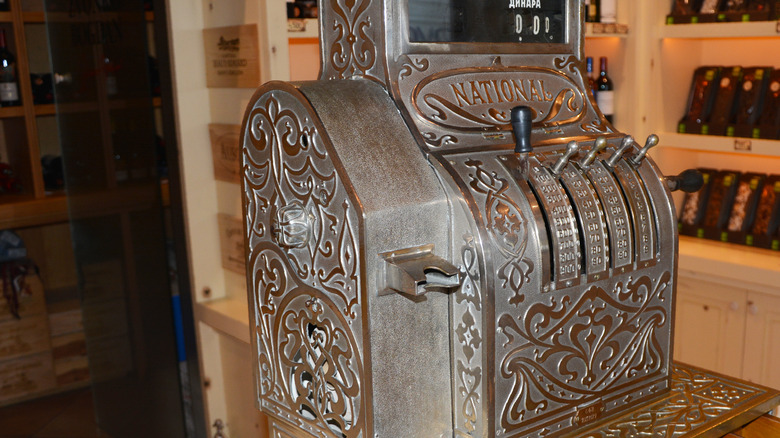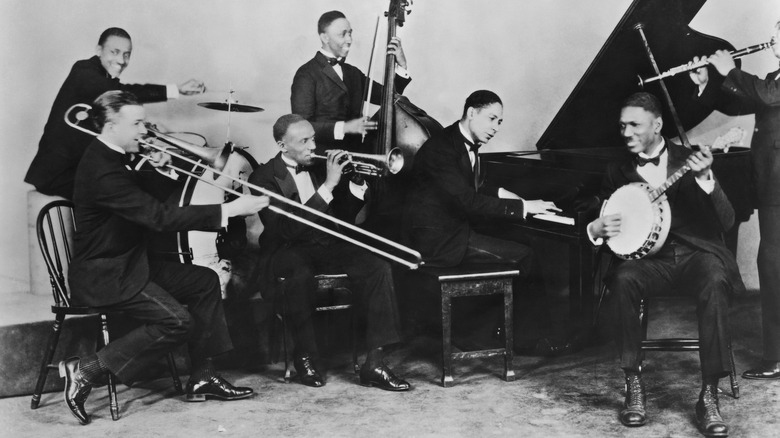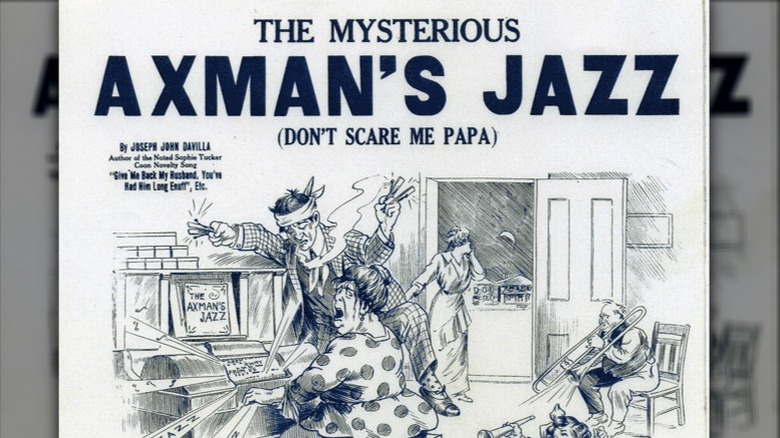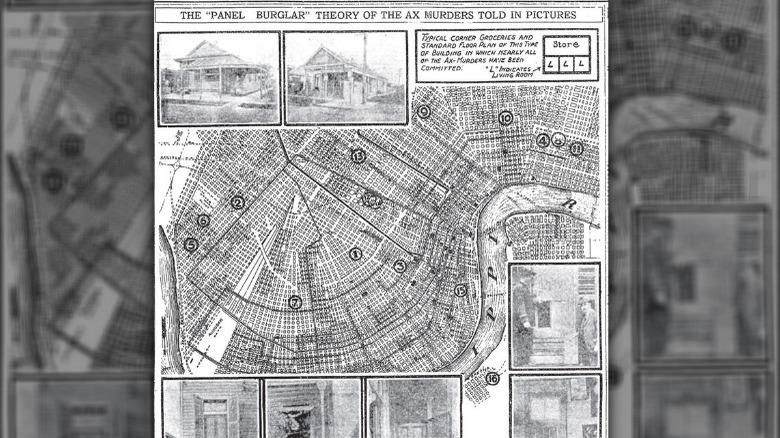The Alleged Motive For The Axeman Of New Orleans' Crime Spree
Throughout history, many serial killers have had a type of victim to which they gravitated. For instance, Jack the Ripper preferred to prey on sex workers, and the Son of Sam had a predilection for couples in cars, but very few of them have been as fussy about who they murdered as the Axeman of New Orleans. This serial killer who terrorized the Crescent City — as Louisiana's largest metropolis is often called — only killed Italians. But even more specifically, he only attacked Italian grocers, according to Reveille.
To make things even stranger, the Axeman, who attacked as many as a dozen people — mostly in New Orleans but also in other areas of Louisiana between 1918 and 1921 — allegedly had ties to a brand new kind of music, according to Film Daily. This musical style was born in New Orleans and was just then gaining ground with younger listeners. And the Axeman swore he wouldn't kill anyone who listened to this kind of music when he went hunting for his next victims, per WBUR.
The Axeman Preyed on Italian Immigrants
On the night of May 23, 1918, Andrew Maggio, drunk after a night out in New Orleans, came home to his Uptown apartment but went next door to his brother's place after hearing strange noises from inside, according to Reveille. In the apartment at the back of their grocery store, Andrew discovered his brother, Joseph, and Catherine, his sister-in-law, covered in blood, their throats slit and with massive head wounds made by an axe (via The Buffalo Times). The police initially believed Andrew Maggio, a barber, was behind the killings since a razor had been used on the victims' throats, but it wasn't long before the grisly murders were instead linked to a serial killer stalking the streets of the Big Easy.
Over the next year, from the spring of 1918 to the spring of 1919, the Axeman of New Orleans, as the newspapers dubbed the killer, preyed on Italian grocers using their own axes to do his bloody work across the city, per Smithsonian Magazine. He would chisel out a part of a wooden door, slip through the ragged hole, and either kill or maim his victims, according to The Buffalo Times.
Why Italian Immigrants?
Beginning in the 1880s, emigration from Sicily to New Orleans ramped up. A huge influx of immigrants joined an already well-established Northern Italian populace in the city, but the newcomers had an especially hard time since they were typically darker skinned and had to learn a new language. They faced discrimination and suspicion from locals, especially the Irish, who had settled in New Orleans earlier, per NewOrleans.com, the city's official tourism site. Despite the prejudice against them, these immigrants were eventually able to establish themselves in their new homeland, many of them in the grocery business, per Reveille.
When the killings began, police and the press initially blamed the crimes on a private vendetta amongst the Italians or on Black Hand blackmailers, a type of crime imported from Sicily in which the perpetrator threatens violence unless a ransom is paid, according to Smithsonian Magazine. Another theory about why the Axeman chose Italians as his victims involves jazz and the first recording of this new style of music made by an Italian-American in 1917.
Is a New Type of Music to Blame?
On March 14, 1919, The Times-Picayune, New Orleans' biggest newspaper, printed a letter allegedly from the Axeman himself. In the cryptic note full of references to the devil and hell, the Axeman claimed he was "very fond of jazz music" and "that every person shall be spared in whose home a jazz band is in full swing" on Tuesday, March 18, 1919, at 12:15 a.m., per WBUR.
At the time, jazz was in its infancy, having been born in New Orleans from a merging of ragtime, West African rhythms, European instrumentation, church hymns, and field chants, according to Jazz Observer. Ferdinand Joseph Lamothe, known professionally as Jelly Roll Morton, a Black New Orleans pianist and composer, would later claim he'd invented jazz. While this isn't strictly true, he was the first person to have a jazz tune published, per Biography. Another claimant as the originator of jazz was Nick LaRocca, an Italian-American New Orleanian whose Original DixieLand Jazz Band recorded in 1917, to great success, per Slate. The theory goes that the Axeman could have been killing his victims as revenge for LaRocca and other Italian-Americans stealing the limelight from Black musicians, according to WBUR.
The Axeman of New Orleans Gets His Very Own Tune
The Tuesday night named by the Axeman of New Orleans was one to remember, with jazz parties held across the city, according to The Historic New Orleans Collection. Not long after the mysterious letter appeared in the newspaper, Joseph John Davilla, a local composer, published a new tune called "The Mysterious Axman's Jazz (Don't Scare Me Papa)" while he "waited for the Axeman to get him," per The Historic New Orleans Collection. The song became a local hit.
The fact that Davilla did so well with the tune (and other clues) led Miriam Davis, author of "The Axeman of New Orleans: The True Story," to surmise that the composer may have been behind the letter purported to be from the Axeman. "He made a pile of money off that song," Davis told WBUR. She also believes the letter writer was probably well educated, while the serial killer was more likely to be a working class.
The Axeman Moves On
In August 1918, New Orleans Police Superintendent Frank Mooney said he believed the killings and woundings were "undoubtedly the work of some brutal, murderous degenerate," whose motive wasn't robbery, per The Buffalo Times. Over the course of the Axeman's killing spree, there were several suspects, including a Black grocery store employee without an alibi and even one victim who had been severely injured and whose mistress claimed he had attacked her, per Heather Monroe. They were all either released or acquitted.
In March 1919, the Axeman attacked a family in Gretna, Louisiana, just across the Mississippi River from New Orleans, killing a 2-year-old child and badly injuring the parents, who were Italian and owned a grocery store, per Heather Monroe. The murderer's modus operandi was similar to those in the New Orleans' crimes, and Mooney was certain it was the same killer, per Smithsonian Magazine. The Gretna authorities refused to believe it and railroaded the victims' neighbors, Iorlando Jordano and his teenage son, Frank, per Reveille. A jury convicted the pair, sending the elder man to prison for life and sentencing Frank to hang. The woman later recanted her testimony, saying the police had forced her to finger her neighbors for the crime, per Smithsonian. The two men were let go, and with that, the trail for the killer went cold. There were three related murders elsewhere in Louisiana, but by 1921, the killings apparently stopped, per Smithsonian. The serial killer has never been identified.





